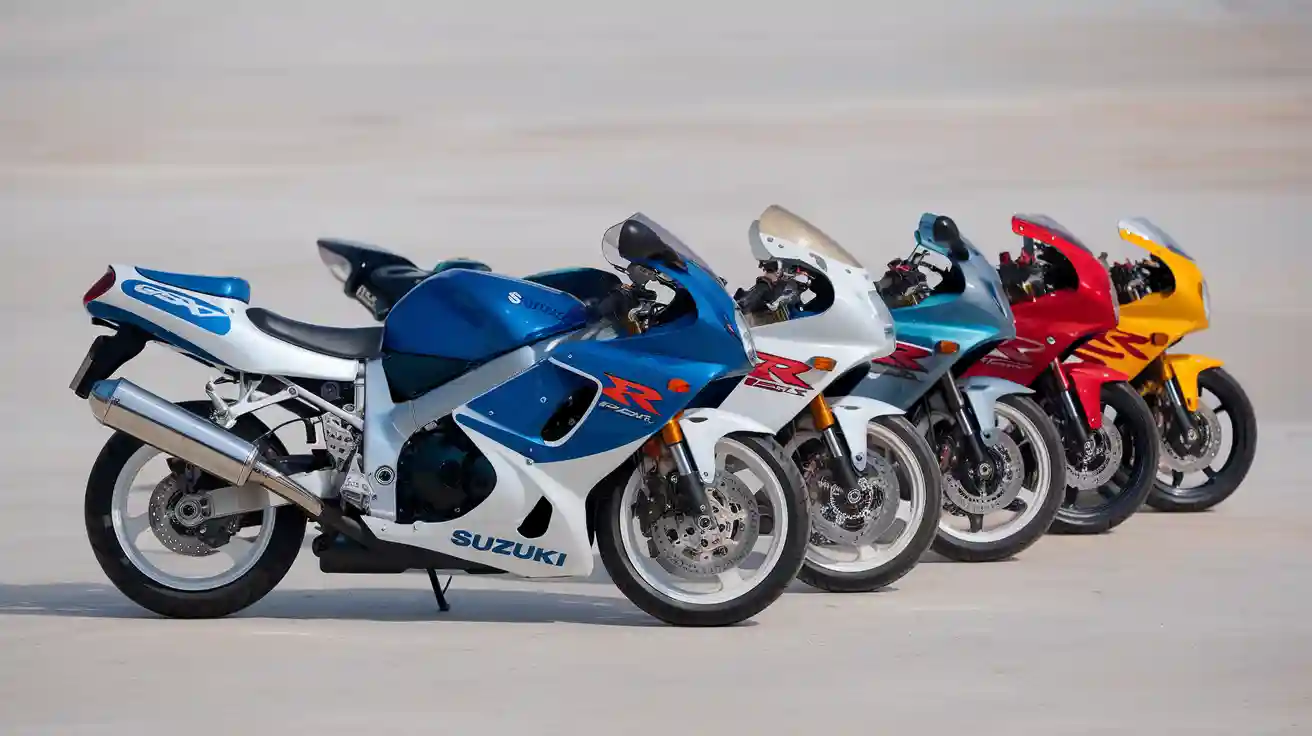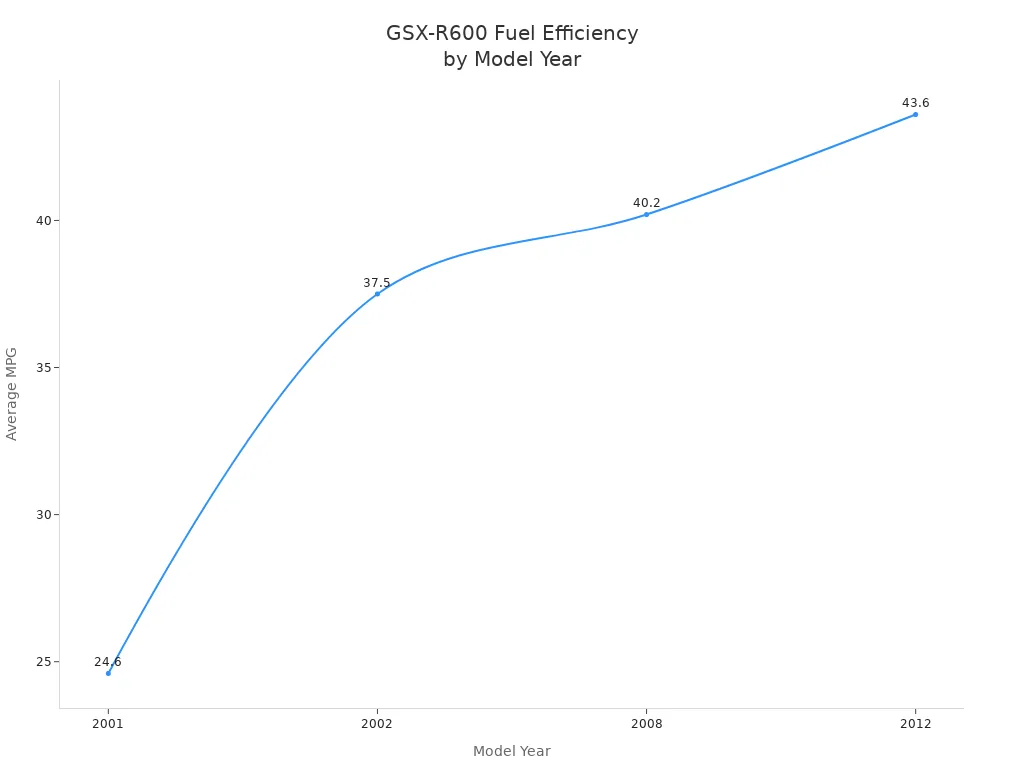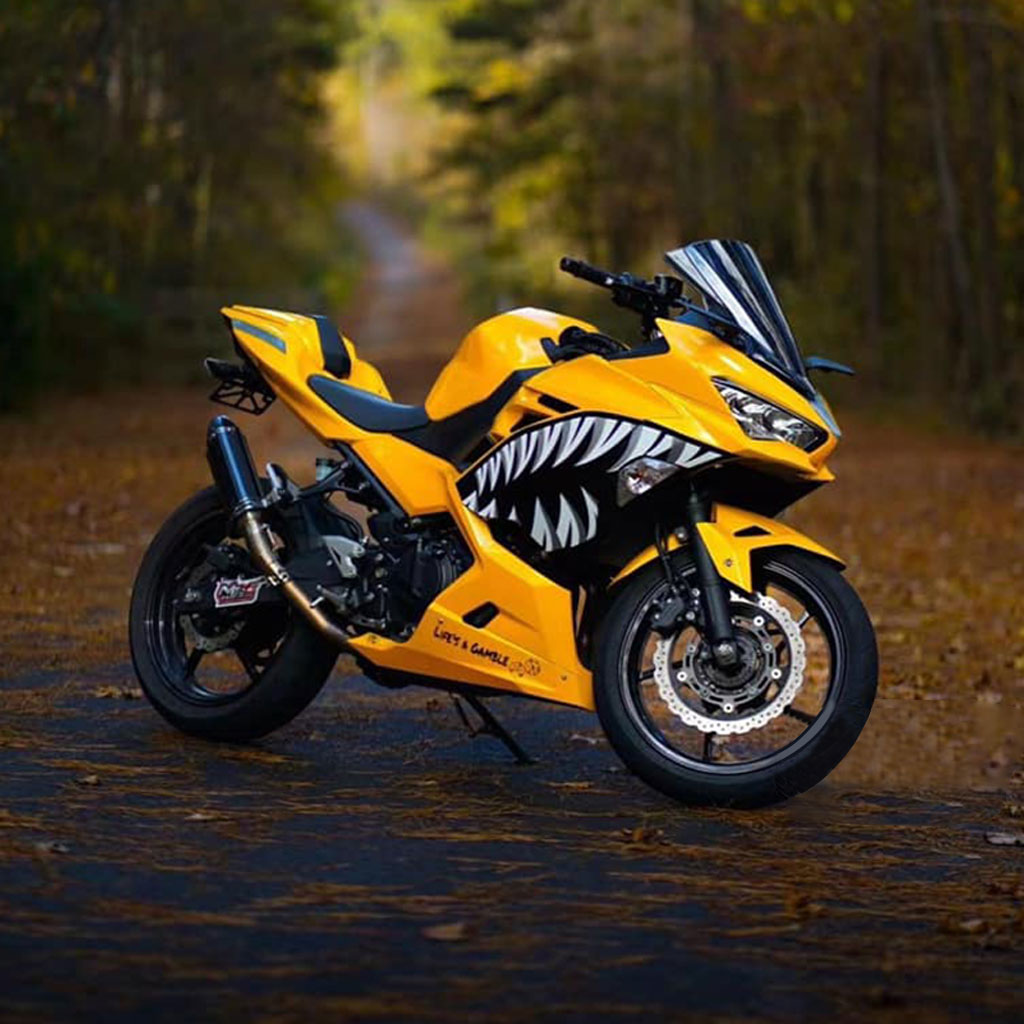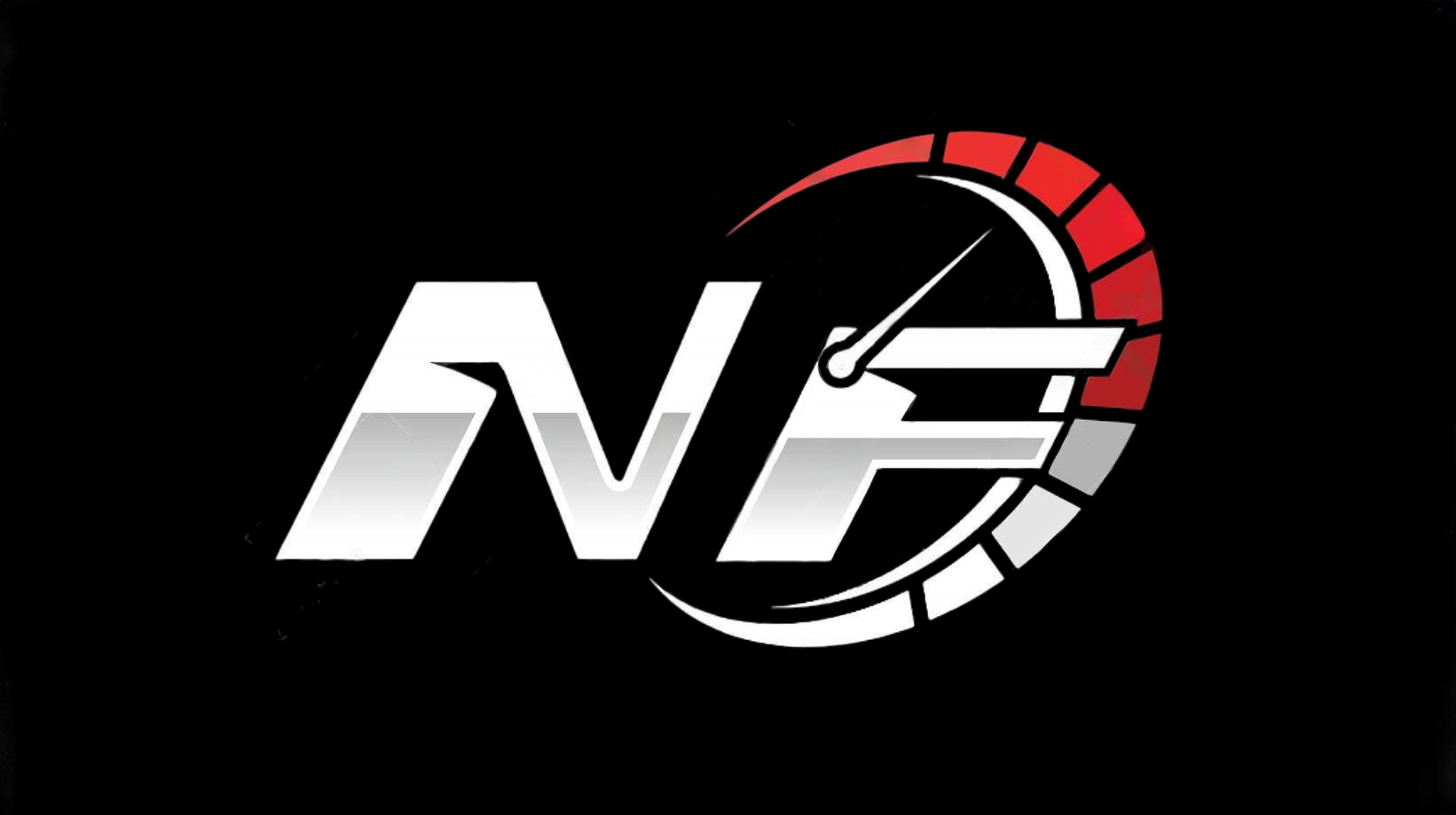How the GSX 600 R 2001 Stacks Up Against Its Successors

When you look at the gsx 600 r 2001, you see a classic suzuki supersport motorcycle that helped shape suzuki gsx-r history. The gsx-r600 models that followed brought new technology, lighter frames, and sharper styling. For example, the 2011 gsx-r600 has a lighter frame, advanced Showa suspension, and Brembo brakes. The table below shows how the two suzuki motorcycles compare:
| Feature | gsx 600 r 2001 | 2011 gsx-r600 |
|---|---|---|
| Weight | Heavier | About 20 lbs lighter |
| Suspension | Conventional | Showa Big Piston Forks |
| Brakes | Standard Japanese | Italian Brembo calipers |
| Technology | Basic | Modern ECU, riding modes |
You may find that the gsx 600 r 2001 still delivers reliable performance, simple maintenance, and a connection to suzuki gsx-r history. Many riders value the pure sport feel and super sport legacy that this model offers.
GSX 600 R 2001 vs. Later GSX-R Models: Engine and Performance
Power Output and Acceleration in the gsx 600 r 2001
When you look at the gsx 600 r 2001, you see a 600cc engine that helped set the standard for suzuki racing bikes. This engine produces 115 hp at 13,000 rpm and 69.0 Nm of torque at 10,500 rpm. Later gsx-r600 models improved these numbers, reaching about 125 hp at 13,500 rpm. Torque in newer models ranges from 52.5 Nm to 67.7 Nm, which means you get more power but sometimes similar torque.
Here is a table that shows how the engine specs compare:
| Specification | GSX-R600 2001 Model | Later GSX-R600 Models (General) |
|---|---|---|
| Engine Displacement | 599 cc | ~600 cc (consistent across models) |
| Horsepower | 115 hp @ 13,000 rpm | Around 125 hp @ ~13,500 rpm |
| Torque | 69.0 Nm @ 10,500 rpm | Ranges approx. 52.5 Nm to 67.7 Nm |
You may wonder about acceleration and top speed. While there is no exact 0-60 mph or quarter-mile data for the gsx 600 r 2001, newer gsx-r600 models from 2011-2013 can reach 60 mph in about 3.34 seconds and finish the quarter-mile in 11.03 seconds at 130 mph. These numbers show that suzuki kept pushing for better racing performance and higher speed with each new generation.
Throttle Response and Power Delivery Across GSX-R Generations
You will notice a difference in throttle response when you ride different gsx-r generations. The gsx 600 r 2001 uses a Suzuki Dual Throttle Valve (SDTV) fuel injection system. This system gives you a smooth throttle feel, almost like a carburetor, but with better control. When you twist the throttle, the engine responds cleanly, especially at part-throttle. At high rpm, you get a strong rush of power, which makes the bike exciting on the track and in racing situations.
Later gsx-r600 models add more electronic features. These bikes give you more power, but some riders say they lose a bit of the raw, direct feeling that made the early 2000s suzuki bikes special. Electronic rider aids help you control the bike, but they also change how the engine delivers power. If you want a pure, thrilling ride, you might prefer the older gsx-r. If you want more control and safety, the newer models offer that.
Engine Updates in gsx-r600 Models After 2001
Suzuki made a big leap in engine development with the 2001 gsx-r600. The engine became smaller, lighter, and more advanced. Engineers used new casting methods to make the cylinders part of the upper case half. They also redesigned the combustion chamber and improved cooling. This made the engine lose 9 pounds and increased its power output by 14 hp compared to the previous year. The new engine-management system gave you better ignition timing and fuel injection, which helped both racing and street riding.
After 2001, suzuki focused on small improvements. The 2004 gsx-r600 got a 4% power boost and lost about 1.2% in weight. In 2006, suzuki added dual injectors and a slipper clutch, which came from the bigger GSX-R1000. These changes helped with racing and track stability. The engine also became more compact, which allowed for a longer swingarm and better weight balance. Cooling systems improved over time, helping the engine run better during hard racing sessions.
Fuel efficiency also improved in later models. The 2001 gsx-r600 averaged about 24.6 mpg, while the 2012 model reached 43.6 mpg. This means you can ride longer between fill-ups, which helps during long track days or racing events.

You can see that suzuki kept making the engine better, but most changes after 2001 were small. The focus shifted to refining cooling, weight, and racing features instead of big redesigns. This steady development helped the gsx-r600 stay strong in competition and on the track.
GSX-R600 Design and Ergonomics Evolution

Styling Changes from the gsx 600 r 2001 to Newer gsx-r600 Models
Suzuki made big changes to the look of the gsx-r600 over the years. You can see the most important styling updates in these steps:
- Early 2000s models, like the gsx 600 r 2001, had a larger and wider body. The fuel tank looked big and the motorcycle felt heavier.
- In 2004, Suzuki gave the gsx-r600 a sharp, pointed design. The tail became sleeker and the whole bike looked more modern.
- By 2005, the body got slimmer. The motorcycle started to lose its bulky look.
- The 2006 model became even thinner and smaller. Suzuki lowered the seat height and moved away from the full fairing style.
- After 2006, the gsx-r600 looked more aggressive and sporty, matching the style of modern racing bikes.
These changes helped Suzuki reduce weight and improve the motorcycle’s aerodynamics.
Rider Comfort and Seating Position in the gsx-r Line
When you sit on a gsx-r, you notice the aggressive riding position. The gsx 600 r 2001 has a seat height of 830mm, low handlebars, and rearset footpegs. This setup puts you in a forward-leaning stance, which helps with sport riding. The narrow tank lets your legs grip the motorcycle better. Newer gsx-r600 models keep the same seat height and handlebar position. Suzuki designed both old and new models for performance, not comfort. You get good wind protection, but the seat and bars make long rides less relaxing. The focus stays on handling and weight balance.
Instrument Cluster and Controls: 2001 vs. Later GSX-R600
You will find differences in the instrument clusters between the gsx 600 r 2001 and newer gsx-r600 models.
- The 2001 model uses an analog speedometer with a mechanical cable drive.
- Newer gsx-r600 motorcycles have digital speedometers.
- Suzuki changed the wiring and mounting tabs after 2000, so the clusters are not interchangeable.
- The ECU in newer models works differently, which affects how the controls and gauges function.
These updates give you more information and a modern look on recent gsx-r600 motorcycles, but the basic controls stay simple and easy to use.
GSX-R Technology and Features Over the Years
Electronic Advancements in gsx-r600 Models
You can see how suzuki has pushed the boundaries of motorcycle technology with each new gsx-r600. In the early 2000s, the gsx-r600 used a basic electronic control unit (ECU) and simple fuel injection. Later models brought more advanced ECUs that let you adjust fuel maps for better performance. Suzuki added features like dual throttle valves and improved ignition timing. These changes gave you smoother power and better throttle response. In recent years, you get digital dashboards and more precise sensors. This technology helps you ride with more confidence and control.
Safety Features in the gsx 600 r 2001 and Successors
Suzuki focused on safety as the gsx-r line evolved. The gsx 600 r 2001 gave you strong brakes and a stable frame. Later gsx-r600 models added even more safety features. You get better brake calipers, like Brembo units, and improved suspension for safer handling. Some newer models offer optional anti-lock braking systems (ABS). This feature helps you stop safely, even on wet roads. Suzuki also improved the headlights and turn signals for better visibility. These updates help you stay safe while enjoying the thrill of riding.
Tip: Always check your brakes and lights before every ride. Good maintenance keeps you safe on any suzuki motorcycle.
Convenience and Rider Aids in Modern GSX-R600
Modern gsx-r600 motorcycles give you more convenience than ever before. Suzuki added features that make your ride easier and more enjoyable. You get digital gear indicators, adjustable levers, and lighter clutch pulls. Some models include lap timers and programmable shift lights. These rider aids help you focus on the road or track. Suzuki also made the seats and controls more comfortable for longer rides. With these updates, you can enjoy both daily commuting and weekend adventures.
GSX-R600 Handling and Ride Quality Comparison
Suspension and Chassis Improvements Since the gsx 600 r 2001
You can feel a big difference in suspension and frame design when you ride the gsx 600 r 2001 and then try newer models. The 2001 bike uses a traditional telescopic fork and a basic rear shock. This setup gives you a solid ride, but it feels stiff during hard racing. Suzuki wanted you to have a strong frame for better racing stability, so the engineers made the frame wider and heavier.
After 2001, Suzuki focused on chassis development. You get Showa Big Piston Forks in later models. These forks help you control the bike better during fast cornering. The rear shock also improves, giving you more comfort and grip. Suzuki makes the frame lighter and stiffer. This change helps you move the bike quickly from side to side during racing. The lighter weight means you use less effort to steer. You notice the bike feels more balanced and easier to handle, especially on a racing track.
Note: A lighter frame and better suspension help you ride faster and safer during competition.
Braking Systems in gsx-r Models
Braking plays a huge role in racing and daily riding. The gsx 600 r 2001 comes with standard Japanese brake calipers and rotors. These brakes give you good stopping power, but you need to squeeze the lever hard during racing. The brakes work well for street use, but you may notice some fade after many hard stops.
Suzuki upgrades the braking system in later gsx-r models. You get Italian Brembo calipers, which give you stronger and more consistent stopping power. The new brakes feel sharp and easy to control. Some newer models also offer anti-lock braking systems (ABS). ABS helps you stop safely, even if you brake hard during wet racing conditions. The lighter frame and better brakes work together to give you more confidence in competition.
Here is a quick comparison:
| Model Year | Brake Calipers | ABS Option | Braking Feel |
|---|---|---|---|
| gsx 600 r 2001 | Standard Japanese | No | Firm, but can fade |
| Later gsx-r600 | Brembo (Italian) | Yes (some) | Strong, consistent |
Overall Ride Dynamics: 2001 vs. Later GSX-R600
When you ride the gsx 600 r 2001, you feel the bike’s weight and solid frame. The motorcycle feels stable at high speed, which helps you during long racing sessions. The older frame design gives you a sense of security, but it can feel heavy when you try quick direction changes. You need to use more effort to lean the bike into corners.
Newer gsx-r models change the ride completely. The lighter frame and improved suspension make the bike feel nimble. You can flick the bike from side to side with little effort. The chassis development in recent years helps you keep control during hard racing. The bike feels planted in corners and stable during braking. You get better feedback from the road, which helps you push harder in competition.
Tip: If you want a bike for serious racing, you will enjoy the quick handling and light weight of newer gsx-r models. If you prefer a stable ride with a classic feel, the 2001 model gives you that experience.
You can see that Suzuki’s focus on frame, suspension, and braking has made the gsx-r line a top choice for racing and competition. Each update helps you ride faster, safer, and with more confidence.
GSX 600 R 2001 Reliability and Maintenance vs. Newer GSX-R600
Durability and Common Issues in gsx-r Generations
When you own a suzuki sport bike, you want to know how reliable it is. The gsx 600 r 2001 has a strong reputation, but some owners have reported a few common problems. Here are some issues you might face with this model:
- Melted stator plug, which can lead to replacing the stator, regulator/rectifier, and burnt plug
- Slipping first gear, sometimes noticed by riders
- Fork seals that may need replacement
- Main wiring harness that could require a full swap
- ECU that might need to be replaced
These problems mostly affect the electrical system and engine components. Newer suzuki gsx-r600 models do not show a clear pattern of different or more frequent issues, so you can expect similar durability across generations. Regular checks help you catch these problems early.
Maintenance Requirements for the gsx 600 r 2001 and Beyond
You will find that suzuki keeps maintenance simple for both older and newer gsx-r600 models. The engine in every generation needs an oil change every 6,000 km. You should replace spark plugs every 12,000 km and inspect the engine valves every 24,000 km. Even though suzuki added new features like Showa Big Piston Forks and Brembo brakes after 2011, the basic service schedule did not change. You use similar parts for oil, filters, and fluids. Only small things, like air filters or brake pads, might differ. Maintenance costs stay about the same, so you do not face extra work or higher bills with a newer engine.
Tip: Stick to the recommended schedule to keep your suzuki engine running smoothly for years.
Parts Availability for gsx 600 r 2001 and gsx-r600 Models
You might wonder if you can still find parts for your suzuki. For the gsx 600 r 2001, most engine and chassis parts remain available from suzuki dealers or aftermarket suppliers. You can get common items like oil filters, spark plugs, and brake pads easily. Some unique electrical parts, such as the ECU or wiring harness, may take longer to find, but you can usually source them online or from salvage yards. For newer gsx-r600 models, parts are even easier to get. Suzuki continues to support these bikes, so you can keep your engine and other systems in top shape.
GSX-R600 Value and Ownership Experience
Purchase Price and Resale Value: gsx 600 r 2001 vs. Newer Models
When you look at the market for the GSX 600 R 2001, you will find that it remains an affordable motorcycle for many riders. According to recent data from Kelley Blue Book, you can expect to pay around $2,270 for a 2001 model in good condition with average mileage at a dealership. This price makes it a budget-friendly choice if you want to enter the world of Suzuki sport bikes. Information about resale values for newer GSX-R600 models is not widely available, so you may find it harder to compare prices directly. Still, the 2001 version stands out as a cost-effective way to enjoy a reliable and respected motorcycle.
Community Support and Aftermarket Options for gsx-r600 Owners
You will discover a dedicated online community for the GSX 600 R 2001. Riders often gather on forums to share advice and experiences. Many discussions focus on technical upgrades, such as swapping front forks or adding performance parts. Here are some common topics you might see:
- Technical modifications, like front end swaps with newer forks
- Advice on parts compatibility and installation
- Personal stories about upgrades and repairs
- Tips for finding aftermarket parts, such as RaceTech valves or Brembo brakes
These conversations show that you can find practical help and peer support. The community for the 2001 model is active, but it may feel more focused on technical details than on general riding. You will also notice that aftermarket support covers a wide range of upgrades, helping you personalize your motorcycle.
Suitability for Different Types of Riders in the gsx-r Line
The GSX-R600 line offers something for many types of riders. If you want a classic motorcycle with a strong connection to Suzuki’s sport heritage, the 2001 model gives you that experience. You can enjoy a simple, reliable ride that still feels fast and exciting. Riders who like to modify their bikes will find plenty of options for upgrades, from exhaust systems to brake components. Newer GSX-R600 models may suit you if you want advanced features and lighter handling. No matter which version you choose, you join a group of riders who value performance and community.
You see clear differences between the GSX 600 R 2001 and newer GSX-R600 models. The 2001 bike gives you strong track performance and fast acceleration. Newer models, like the 2006 version, add fuel injection and better comfort for daily rides. If you want a pure racing feel, the 2001 model fits you best. Riders who need more comfort and modern features should look at newer GSX-R600s.
The GSX 600 R 2001 still stands out for track use, but newer models offer a better balance for street and sport riding.
FAQ
What makes the GSX 600 R 2001 special compared to newer GSX-R600 models?
You get a classic sport bike with a raw riding feel. The 2001 model gives you simple maintenance and a strong connection to Suzuki’s racing history. Many riders value its direct throttle response and solid build.
Can you still find replacement parts for the GSX 600 R 2001?
Yes, you can find most parts from Suzuki dealers or aftermarket suppliers. Some unique electrical parts may take longer to locate. Online forums and salvage yards often help you source rare components.
Is the GSX 600 R 2001 a good choice for beginners?
You can ride the GSX 600 R 2001 as a beginner, but it has a sporty riding position and strong power. If you want a more comfortable or forgiving bike, you might look at smaller or newer models.
How does the GSX 600 R 2001 perform on the track?
You experience stable handling and quick acceleration on the track. The solid frame and responsive engine help you push hard in corners. Many riders use this model for track days and club racing.
See Also
2006 GSXR 600 Fairings That Shape Your Riding Style
Reasons Kawasaki ZX10RR Beats ZX10R In The Year 2025
Best Aftermarket Fairings For ZX6R Thoroughly Evaluated
Advantages Of Carbon Fiber Fairings On 2014 GSXR 1000
Comprehensive Analysis Of Ninja 650 Kawasaki Fairing Performance

